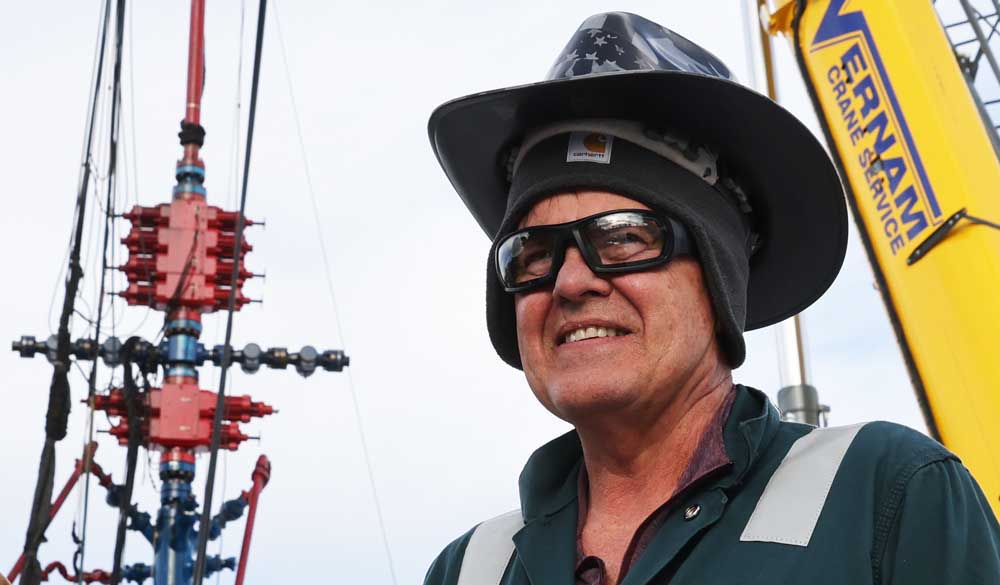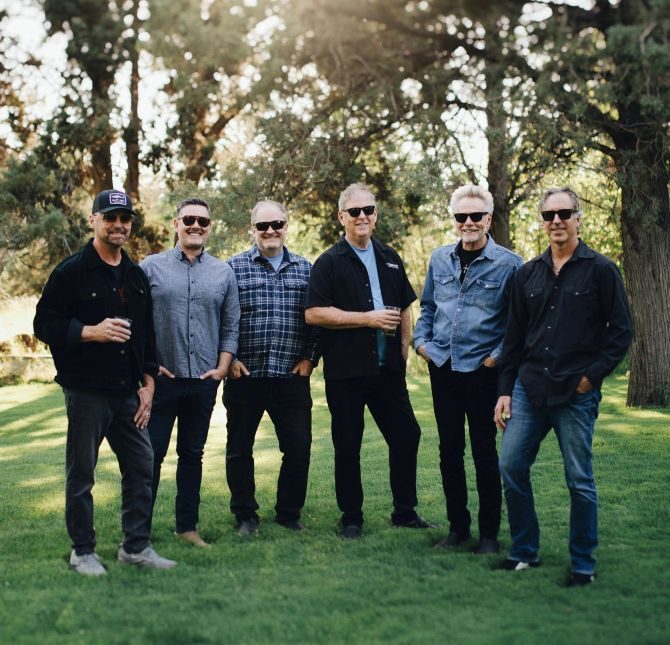Can super hot rocks under Newberry Volcano produce clean energy?
Published 5:45 am Saturday, January 11, 2025

- Pat Brand, director of operations with Mazama Energy, is pictured at the geothermal technical project at Newberry Volcano, where the energy company is testing using super hot rocks below the earth to generate electricity.
On the western slopes of Newberry Volcano, a group of scientists and geologists are attempting an unusual mining project. They are not after minerals. Rather, they are mining heat.
The project, 23 miles southeast of Bend, will take advantage of heat deep below the surface of the Earth to produce steam that can power turbines — a potentially inexhaustible source of carbon-free energy. Steam production from “super hot rocks” has projected costs similar to solar or wind power generation.
Newberry Volcano is usually thought of locally as a place to hike, fish and camp. But if the technology tested here can be proven to work and is financially viable, it can be replicated in other parts of the world, a potential game-changer in the global fight against climate change.
Here is some background on the energy project about to go down on Bend’s doorstep.
Who is developing the project?
Geothermal studies and exploration at Newberry Volcano have been ongoing for decades. Most of the recent work was conducted by Seattle-based AltaRock Energy, Inc. which focussed on testing an Enhanced Geothermal System with several partners including the Department of Energy and national laboratories and universities.
Read more: ‘The potential is huge’: AltaRock pursues geothermal energy at Newberry Crater
In 2023, Texas-based Blade Energy Partners Ltd. and AltaRock Energy formed a new company, Mazama Energy Inc. to scale up the Newberry Project, with the goal of producing power from super hot rocks. Mazama’s biggest investors include Vinod Khosla, a prominent venture capitalist who co-founded Sun Microsystems in the 1980s.
Where is the project?
The project site is two miles west of Paulina Lake, just outside the boundary of Newberry National Volcanic Monument. The monument was formed in 1990 and is inside the Deschutes National Forest. Due to environmental protections, Mazama cannot drill into the national monument, nor can it drill diagonally and then under the monument.
Newberry is a shield volcano spanning 1,200 square miles, covering an area roughly the size of Rhode Island. Drilling work in the caldera conducted by the University of Oregon two decades ago has revealed temperatures of 540 degrees at depths of 3,000 feet below the caldera floor. UO researchers located a magma chamber around 2 miles below the surface.
An eruption last occurred here 1,300 years ago, producing Big Obsidian Flow, and scientists expect that the Newberry will eventually erupt again.
What is unique about the location?
Alain Bonneville, chief geoscientist with Mazama Energy, says the location is unique because the crews only need to drill around 15,000 feet into the ground to reach rocks with temperatures of 752 degrees .
In other regions of the U.S., geologists would need to drill twice that depth to reach super hot rocks.
“It’s an opportunity to test (the technology) here because we don’t have to go too deep to find this temperature,” Bonneville said.
While the super hot rocks at Newberry are found at shallow depths, Bonneville says this project could serve as a model for similar power production plants in other places where scientists find similar conditions, only at deeper levels.
What are the demonstration nuts and bolts?
Step one for Mazama is to reenter an existing well and stimulate the hot rock with water to create fractures using technology developed by the oil and gas industry. The network of fractures, which are just millimeters wide, will extend around 300 feet from the well. The stimulation generates earthquakes of magnitude 1 or less.
In step two, instruments on the surface map out the presence of the fractures during the stimulation of the rock. Proppants are then injected into the fissures to keep them open. Proppants are a solid material designed to keep an induced hydraulic fracture open. Mazama will be using ceramic materials for this process.
Step three: a new test well is drilled and flow tests between two wells will occur. All three steps are planned for early 2025.
Is this safe for the environment?
Geothermal plants are considered among the least impactful to the environment compared to other renewable power plants. Importantly, geothermal projects do not depend on above-ground variable weather conditions (like solar or wind) or unpredictable streamflows (like hydropower).
Geothermal plants also sit on a smaller footprint than solar or wind farms. Because of this small footprint, their existence has a lower impact on fish and wildlife compared to other renewable power plants.
The Newberry project will require water from an external groundwater source but what is added stays there and can be reused as the steam is returned underground after condensation.
How will water be used and sourced?
The best-known geothermal projects on the planet are happening in Iceland. But in Iceland, rock is permeable and contains water, which can then be drawn to the surface to power turbines.
At Newberry, the rock is impermeable and contains no water — for the project to work, water needs to be injected into the underground reservoir. The source of the water is underground well water near the test site. Because it requires water it is known as an enhanced geothermal system .
Bonneville says no impact on water quality from geothermal activities has ever been observed at Newberry.
“To ensure this remains the case, water quality is being monitored and analyzed at seven locations on the western flank (including water wells and the hot seeps of East and Paulina Lakes) before, during, and after the stimulation,” said Bonneville.
Are there any models for this technology?
In many ways, this is a pioneering project pushing the boundaries of geothermal exploration. The only other comparable example to the Newberry project is Utah FORGE, a laboratory for enhanced geothermal development in southern Utah. This U.S. government-funded project drilled wells to 8,000 feet , reaching 442 degrees .
Who else is involved?
Mazama received $20 million in funding for its research from the U.S. Department of Energy. The source of the funding is the Biden administration’s bipartisan infrastructure law, issued to support Biden’s goal of 100% clean electricity by 2035.
Mazama has partnered with three national labs: The Pacific Northwest National Lab in Richland, Washington , the Lawrence Berkley National Lab in Berkley, California, and the National Renewable Energy Lab in Boulder, Colorado . The University of Oklahoma and Oregon State University are also project partners.
OSU-Cascades is working with Mazama on a community benefit plan, including the development of a local workforce and other benefits related to carbon-free energy production. OSU students will also be able to visit the test site to observe how the data is collected and will help with the analysis portion of the project.
What are the next stages of development?
In later stages of development, the fractures will allow Mazama to create an underground “reservoir” where injected water can reach 752 degrees .
Between 2025 and 2027, two wells are planned to be drilled in the super hot rock with a reservoir between them where water can be circulated. Proving up the technology involves consistent steam production for at least four months. Once the demonstration shows that steam can be produced, Mazama could commence the power plant permitting process, including a full environmental assessment.
Commercial production of power could occur by 2030. At that stage, Mazama would likely partner with a more traditional power producer to operate the power plant. The target is to have one injector well and two producer wells, generating 50 megawatts of electricity.
Bonneville says this would be enough to satisfy approximately half of Bend’s peak power demand.
Technology decoder
SHR: Super Hot Rock. Refers to underground rock with temperatures over 752 degrees Fahrenheit (400 degrees Celsius).
EGS: Engineered Geothermal Systems. A geothermal system in otherwise dry rock (without natural steam). The system is created by injecting water into fractures in underground rock where it is heated and returned to the surface for energy production. Most EGS development to date has been in rock that is 302 to 572 degrees Fahrenheit (150 to 300 degrees Celsius).
Supercritical: The state of water that is returned to the surface after being heated by super hot rock.








